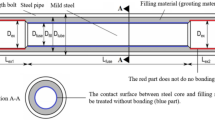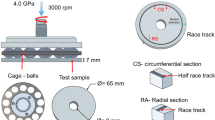Abstract
Combined shear and tension (CST) tests are important experimental methods for characterizing yield surfaces for metal sheets, which is vital to ensure the effectiveness of the constitutive models employed in finite element simulation. However, the existing CST experimental method with a reduced thickness specimen, designed for advanced high strength steel sheets, is not suitable for accurately characterizing yield surfaces for lightweight alloy sheets, such as aluminum alloy sheets. In this paper, an improved experimental method employing CST loading along with an appropriate full-thickness specimen is proposed to address the problem. To establish the proposed experimental method, an appropriate full-thickness specimen is presented through finite element method and combined with a newly developed biaxial testing machine. To verify the effectiveness and feasibility of the improved experimental method, virtual simulations and real experiments on the proposed full-thickness specimen obtained from 6K21-T4 aluminum sheets under different CST loading cases are conducted. Research results show that the yield surfaces of the aluminum alloy sheets between simple shear and plane strain (SSPS) can be described accurately by employing the improved experimental method. In addition, according to the experimental results, the prediction capability of the Yld2000 and Hill48 yield criteria is studied. It is found that the commonly used Yld2000 yield criterion cannot accurately predict the yield behavior of the aluminum alloy sheets under shear-dominant loading.




















Similar content being viewed by others
References
Dursun T, Soutis C. Recent developments in advanced aircraft aluminum alloys. Mater Des. 2014;56:862–71.
Ingarao G, Micari F. Sustainability issues in sheet metal forming processes: an overview. J Clean Prod. 2011;19:337–47.
Ablat MA, Qattawi A. Numerical simulation of sheet metal forming: a review. Int J Adv Manuf Tech. 2017;89:1235–50.
Banabic D. Anisotropy of sheet metal. In: Banabic D, editor. Formability of metallic materials: plastic anisotropy, formability testing, forming limits. Springer; 2000. p. 119–72.
Shiratori E, Ikegami K. A new biaxial testing machine with flat specimens. Bull Tokyo Inst Technol. 1967;82:105–18.
Hannon A, Tiernan P. A review of planar biaxial tensile test systems for sheet metal. J Mater Process Technol. 2008;198:1–13.
Hanabusa Y, Takizawa H, Kuwabara T. Numerical verification of a biaxial tensile test method using a cruciform specimen. J Mater Process Technol. 2013;213:961–70.
Mitukiewicz G, Głogowski M. Cruciform specimen to obtain higher plastic deformation in a gauge region. J Mater Process Technol. 2016;227:11–5.
Hou Y, Min JY, Guo N, Lin JP, Carsley JE, Stoughton T, Traphöner H, Clausmeyer T, Tekkaya AE. Investigation of evolving yield surfaces of dual-phase steels. J Mater Process Technol. 2019;287:116314.
Kuwabara T, Horiuchi Y, Uema N, Ziegelheimova J. Material testing method of applying in-plane combined tension-compression stresses to sheet specimen. J Jpn Soc Technol Plast. 2007;48:630–4.
Moreno MCS, Muñoz SH. Elastic stability in biaxial testing with cruciform specimens subjected to compressive loading. Compos Struct. 2020;234:111697.
Zhang K, He ZB, Zheng KL, Yuan SJ. Experimental verification of anisotropic constitutive models under tension-tension and tension-compression stress states. Int J Mech Sci. 2020;178:105618.
Mohr D, Oswald M. A new experimental technique for the multi-axial testing of advanced high strength steel sheets. Exp Mech. 2008;48:65–77.
Mohr D, Jacquemin J. Large deformation of anisotropic austenitic stainless steel sheets at room temperature: multi-axial experiments and phenomenological modeling. J Mech Phys Solids. 2008;56:2935–56.
Mohr D, Dunand M, Kim KH. Evaluation of associated and non-associated quadratic plasticity models for advanced high strength steel sheets under multi-axial loading. Int J Plast. 2010;26:939–56.
Mohr D, Ebnoether F. Plasticity and fracture of martensitic boron steel under plane stress conditions. Int J Solids Struct. 2009;46:3535–47.
Walters CL. The effect of machining the gage section on biaxial tension/shear plasticity experiments of DP780 sheet steel. Exp Mech. 2013;53:1647–59.
Zheng LH, Wang ZJ, Song H. Experimental method for multistage loading tests with various prestrain paths. Exp Mech. 2019;59:51–63.
Zheng LH, Wang ZJ, Wang Z. Characterizing forming limits at fracture for aluminum 6K21-T4 sheets using an improved biaxial tension/shear loading test. Int J Mech Sci. 2019;159:487–501.
Williams BW, Boyle KP. Characterization of anisotropic yield surfaces for titanium sheet using hydrostatic bulging with elliptical dies. Int J Mech Sci. 2016;114:315–29.
Hou Y, Min JY, Guo N, Shen YF, Lin JP. Evolving asymmetric yield surfaces of quenching and partitioning steels: characterization and modeling. J Mater Process Technol. 2021;290:116979.
Kuwabara T, Kuroda M, Tvergaard V, Nomura K. Use of abrupt strain path change for determining subsequent yield surface: experimental study with metal sheets. Acta Mater. 2000;48(9):2071–9.
Li Y, Wang ZJ. Finite element analysis of stiffness and static dent resistance of aluminum alloy double-curved panel in viscous pressure forming. Trans Nonferrous Met Soc. 2009;19:s312–7.
Deng N, Kuwabara T, Korkolis YP. Cruciform specimen design and verification for constitutive identification of anisotropic sheets. Exp Mech. 2015;55(6):1005–22.
Hill R. A theory of the yielding and plastic flow of anisotropic metals. Proc R Soc Lond Seri A. 1948;193:281–97.
Barlat F, Brem JC, Yoon JW, Chung K, Dick RE, Lege DJ, Pourboghrat F, Choi SH, Chu E. Plane stress yield function for aluminum alloy sheets—part 1: theory. Int J Plast. 2003;19:1297–319.
Lee WO, Kim DY, Kim JH, Chung K, Hong SH. Analysis of forming process of automotive aluminum alloys considering formability and springback. Key Eng Mater. 2007;345–346:857–60.
Merklein M, Suttner S. Evolution of yield loci for aluminum alloy AA6016 and deep drawing steel DC06 under the influence of non-linear strain paths. Key Eng Mat. 2013;549:21–8.
Acknowledgements
This research was financially supported by the National Natural Science Foundation of China (No. 52075023, No. 51975031, and No. 51275130). The authors would like to take this opportunity to express their sincere appreciation to the funding.
Author information
Authors and Affiliations
Corresponding authors
Ethics declarations
Conflict of interest
The authors declare that they have no conflict of interest.
Additional information
Publisher's Note
Springer Nature remains neutral with regard to jurisdictional claims in published maps and institutional affiliations.
Rights and permissions
About this article
Cite this article
Zheng, L.H., Wang, Z.J., Wan, M. et al. Yield surface characterization for lightweight alloy sheets via an improved combined shear–tension experimental method. Archiv.Civ.Mech.Eng 22, 96 (2022). https://doi.org/10.1007/s43452-022-00425-5
Received:
Revised:
Accepted:
Published:
DOI: https://doi.org/10.1007/s43452-022-00425-5




